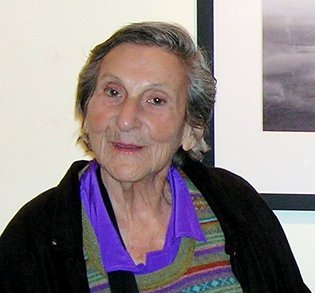
Man Sitting Across from Berenice Abbott’s Studio, Greenwich Village (Commerce Street), NYC” c.1948 Photography by Lida Moser
In honor of Women’s History Month, and our current temporary exhibition of photography, The Open Road: Photography and the American Road Trip, today’s Wednesday Women’s blog focuses on photographer Lida Moser.
Lida Moser (1920-2014) made photographs in a male-dominated field for 60 years, sometimes having to fight for work from editors who were discouraged from hiring women. Shooting everything, she refused to be pigeonholed to one type of photography. “When I became a photographer, I was determined to use photography as a magic key into as many aspects of life as I possibly could—and that I would not limit myself to one category,” Moser said.
Moser is best known for her photography of her home town, which she called “dirty, wild, noisy, criminal New York.” In the 1940s she became a member of the Photo League, a cooperative of New York photographers dedicated to capturing daily life. Her work appeared in magazines including Look, Esquire, and Vogue in the mid-twentieth century. Moser later wrote about photography for The New York Times. Topics in her column ranged from tips such as “Do not lend your camera to anyone” to ways to win grants and contests.
Vogue sent the photographer to Britain to shoot artists, and then to Quebec in 1950 to capture life in small towns, where she garnered success for her work. She also made portraits of famous musicians like Charles Mingus and Leonard Bernstein, as well as surreal and abstracted depictions of New York street life and architecture.
Moser took risks in her subject matter. In her most famous photograph, Judy and the Boys (Mimicry), from 1961, while Moser was photographing a model in front of a Greenwich Village garage, neighborhood children began mimicking the model’s poses. The model’s response with a crude gesture was captured by the photographer.
Although not as well known as Diane Arbus or Dorthea Lang, Lida Moser’s persistence in furthering her career in a male-dominated field and refusal to be relegated to shooting one type of photography, continues to be an inspiration to photographers.
Note: The Crystal Bridges Library holds a collection of 17 photographs made by Moser of her friends, artist John Koch and pianist Dora Zaslavsky Koch, at their New York City apartment between 1954 and 1974. These materials are available for viewing by appointment.





